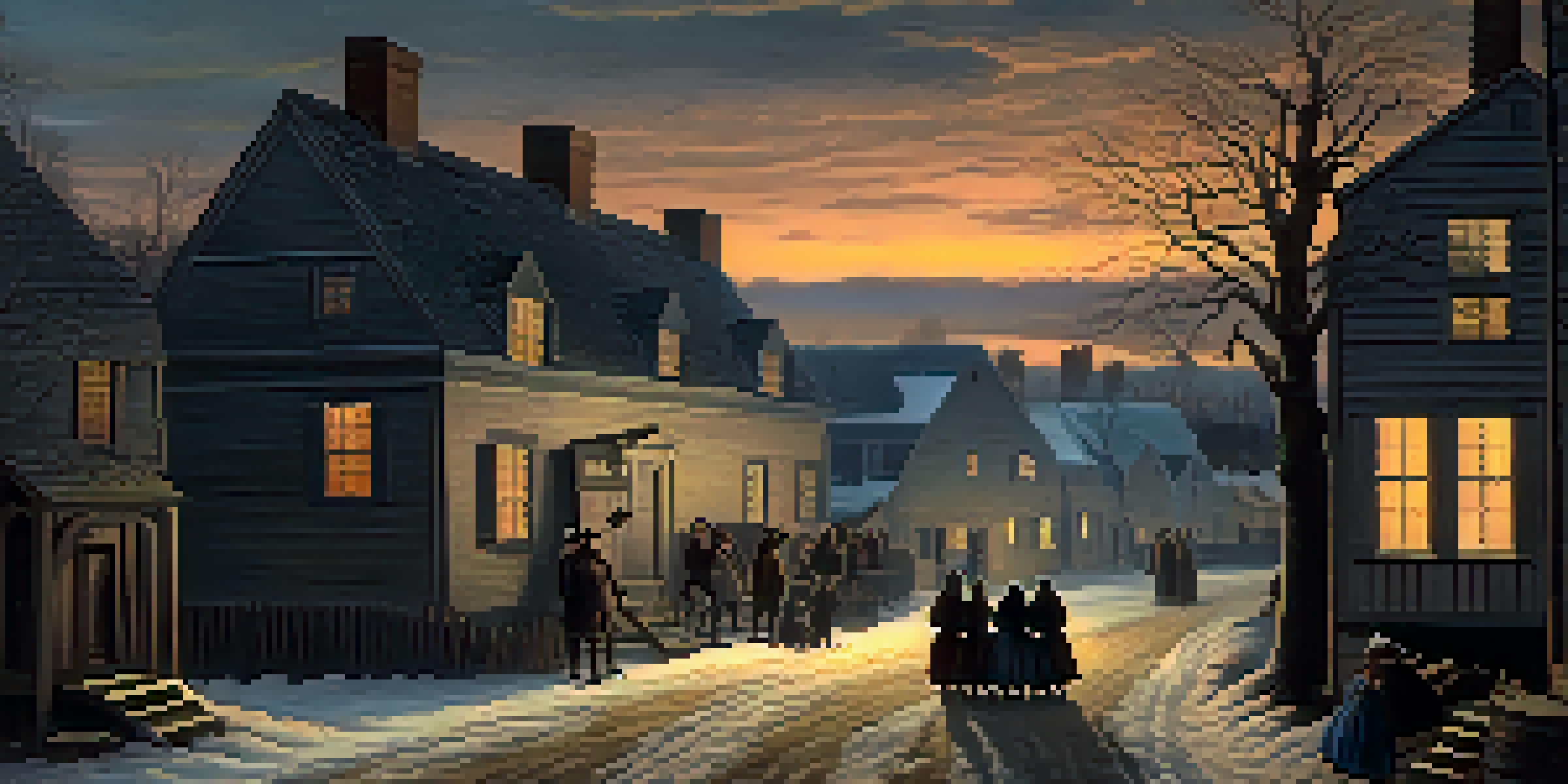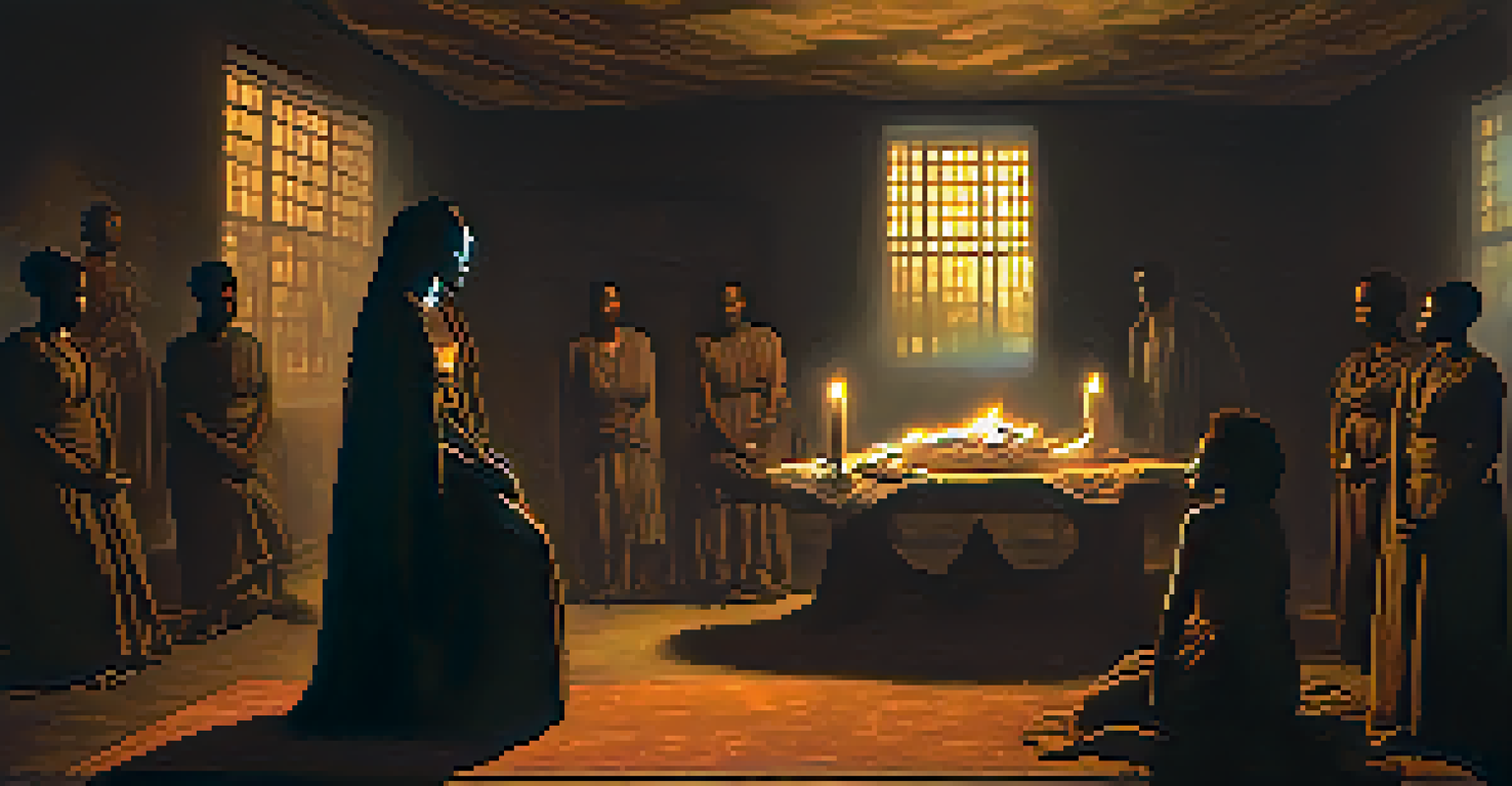Exploring the Salem Witch Trials: A Historic Journey

Understanding the Salem Witch Trials: An Overview
The Salem Witch Trials, which took place in 1692, were a series of hearings and prosecutions of people accused of witchcraft in colonial Massachusetts. This dark chapter in American history is often seen as a cautionary tale about the dangers of extremism and the loss of due process. At the heart of this frenzy were fears of the unknown, fueled by superstition and societal tensions. It’s essential to grasp the context of the time to understand why such hysteria unfolded.
The only thing necessary for the triumph of evil is for good men to do nothing.
In the Puritan community of Salem Village, strict religious beliefs and a rigid social hierarchy created an environment ripe for conflict. The combination of fear regarding the devil and an ongoing struggle for power led to accusations and betrayals among neighbors. The trials resulted in the execution of 20 individuals and the imprisonment of many others, making it one of the most infamous episodes in American history. As we delve deeper into this story, we can see how a mix of fear, power struggles, and societal pressures spiraled out of control.
Over the years, the Salem Witch Trials have been the subject of countless books, movies, and educational programs. They serve as a stark reminder of how mass hysteria can lead to tragic outcomes. By examining the trials, we not only learn about the past but also gain insights into human behavior and societal dynamics. This exploration is crucial, as it helps us recognize and challenge similar patterns in our own lives.
Key Figures in the Salem Witch Trials: Who Were They?
Among the many individuals involved in the Salem Witch Trials, a few key figures stand out. Notably, Tituba, an enslaved woman of Caribbean origin, was one of the first to be accused of witchcraft. Her confessions, filled with vivid imagery of the supernatural, fueled the flames of hysteria and set off a wave of accusations. Tituba’s story highlights the intersection of race and gender in the trials, as she faced intense scrutiny and blame for the community's fears.

Another prominent figure was Reverend Samuel Parris, the minister of Salem Village, whose daughter and niece were among the first afflicted. His zealous nature and desire to protect his family's reputation played a significant role in escalating the accusations. Parris's actions and decisions had a lasting impact on the community, as he became a symbol of the fear and paranoia that gripped Salem. Understanding his motivations reveals much about the societal pressures that drove the trials.
Fear Fueled the Witch Trials
The Salem Witch Trials exemplified how fear and hysteria can distort reality and lead to tragic outcomes.
Then there were the judges and court officials, such as Chief Justice William Stoughton, who upheld the trials and contributed to the tragic outcomes. Their reliance on spectral evidence—testimony that the spirit or specter of the accused was seen committing witchcraft—demonstrated a significant departure from rational legal standards. By examining these figures, we can see how each person's actions contributed to the tragic unfolding of events in Salem.
The Role of Fear and Hysteria in the Trials
Fear is a powerful motivator, and during the Salem Witch Trials, it was the fuel that ignited the chaos. The fear of the devil and the unknown led to irrational thinking and a desperate need to find someone to blame. In this turbulent environment, even the smallest suspicion could lead to dire consequences. The trials illustrated how fear can distort reality, turning neighbors against each other and creating a culture of mistrust.
Injustice anywhere is a threat to justice everywhere.
Hysteria took hold as accusations spiraled out of control, with many individuals jumping on the bandwagon to save themselves. The more people that were accused, the more the community felt compelled to participate in the witch hunt, creating a vicious cycle. This phenomenon is often referred to as moral panic, where emotional responses override logic and reason. By understanding this dynamic, we can recognize how similar patterns can emerge in our society today.
The Salem Witch Trials serve as a historical example of how fear can lead to devastating outcomes. The very fabric of the community was torn apart as friends and families became embroiled in accusations and betrayals. Reflecting on this period helps us appreciate the importance of critical thinking and the need to question the narratives that society presents during times of crisis.
The Impact of Religion on the Salem Witch Trials
Religion played a pivotal role in shaping the events of the Salem Witch Trials. The Puritan faith, with its strict moral code and emphasis on sin, created an atmosphere where any deviation from societal norms was met with suspicion. Accusations of witchcraft were often linked to a perceived failure to adhere to religious doctrine, making it easy for the community to rally around the idea of rooting out evil. This intense focus on spirituality contributed to the urgency of the trials.
Many of the accusers believed they were on a divine mission to protect their community from the influence of the devil. This sense of righteousness fueled the fervor of the trials, leading individuals to act against their own neighbors in the name of faith. The intertwining of religion and law during this period raises important questions about the separation of church and state, a principle that remains vital in modern governance.
Role of Religion in Accusations
Strict Puritan beliefs created an environment where deviations from societal norms were met with suspicion and accusations.
As we look back on the trials, we must acknowledge the profound influence of religious beliefs on societal behavior. The Salem Witch Trials remind us that unchecked zealotry can lead to tragic outcomes. By examining this aspect, we can learn to appreciate the balance between faith and reason that is crucial for a harmonious society.
Legal Proceedings: How Justice Was Served (or Not)
The legal proceedings during the Salem Witch Trials were far from what we would consider fair and just today. The courts relied heavily on spectral evidence, which was based on the testimonies of the afflicted rather than concrete proof. This lack of tangible evidence meant that many individuals were convicted based solely on accusations, leading to wrongful executions and imprisonment. Understanding this flawed legal framework sheds light on the importance of due process in our justice system.
Defendants had little chance to defend themselves adequately, as the fear of the community overshadowed rational debate. The concept of innocent until proven guilty seemed to vanish in the face of mass hysteria. This stark departure from fair legal practices highlights the dangers of allowing fear to dictate justice, reminding us of the importance of protecting the rights of individuals in any legal system.
The aftermath of the trials saw a gradual recognition of these injustices, leading to a reevaluation of the legal processes in America. The Salem Witch Trials ultimately served as a catalyst for reform, as communities began to question the validity of the evidence used in witchcraft trials. Today, we can draw valuable lessons from these historical errors and strive to uphold the principles of fairness and justice in our own legal proceedings.
Consequences of the Salem Witch Trials: A Lasting Legacy
The consequences of the Salem Witch Trials were profound, not only for the individuals directly involved but also for the broader American society. The immediate aftermath saw a wave of guilt and regret as the community grappled with the devastating loss of life and the destruction of reputations. Many survivors had to navigate the wreckage of their relationships and rebuild their lives in a town forever altered by fear and mistrust.
In the long term, the trials left an indelible mark on American culture, influencing literature, politics, and law. The phrase 'witch hunt' has since become synonymous with unjust persecution, serving as a cautionary reminder of the dangers of mob mentality. This legacy continues to resonate today, reminding us to be vigilant against the threats posed by fear and hysteria in our own communities.
Justice System Failures Highlighted
The reliance on spectral evidence during the trials underscored the importance of due process and fair legal practices.
Moreover, the Salem Witch Trials prompted discussions about the need for legal reform and the protection of individual rights. The trials highlighted the importance of due process, leading to changes that would shape the American legal system in the years to come. By studying this legacy, we gain insight into how historical events can create ripples that affect future generations.
Lessons Learned from the Salem Witch Trials
The Salem Witch Trials offer valuable lessons that extend far beyond their historical context. One of the most important takeaways is the need for critical thinking and skepticism in the face of fear. When emotions run high, it’s easy to lose sight of logic and allow misinformation to flourish. By fostering a culture of inquiry and open dialogue, we can prevent similar tragedies from occurring in our own time.
Additionally, the trials remind us of the importance of compassion and understanding in our communities. In the face of adversity, it’s crucial to support one another rather than turn against each other. Empathy can help break down the barriers that fear creates, allowing us to build stronger, more resilient communities. The lessons from Salem encourage us to prioritize connection over division.

Finally, the Salem Witch Trials highlight the ongoing struggle for justice and equality in society. By learning from past mistakes, we can work towards creating a more just world where individuals are treated fairly, regardless of their beliefs or background. The trials serve as a powerful reminder that the fight against injustice is never truly over and that each of us has a role to play in shaping a better future.